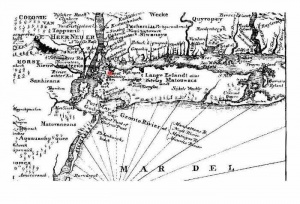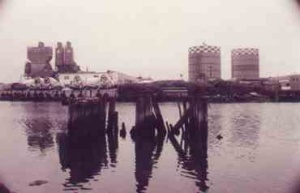Views
Contents |
Maspeth, a History
Colonial History
The area that is now Maspeth was once home to the Mespeatches Native American tribe. The Mespeatches were one of the thirteen main tribes that inhabited the Long Island area. Their village was located just east of what is now Mount Zion Cemetery. Mespeatches means “at the bad waterplace", referring to the stagnant swamps that used to cover the area[1].
Between 1621 and 1638, Dutch West Indian fur traders began settling along the banks of Newtown Creek. The earliest European settlements in the area include the thriving farming plantations and mills of Hans Hansen, Richard Brutnell, Tyman Jansen, Burger Jorissen, and Ensign Dircks, all who held acres of land along the banks of Newtown Creek.[2].
Reverend Francis Doughty, a Quaker clergyman, left Rhode Island with his family and a small group of settlers to establish a settlement free from religious problems in Puritanical New England. He appealed to William Kieft, Director-General of New Netherland, for a land grant through the Newtown Patent. They were granted 13,332 acres on March 28, 1642. This deed is still on file in Albany. It is the oldest deed in Long Island[3].
The actual village of Maspeth was established by Reverend Doughty and a group of twenty-eight English Quakers. The town was originally named "Mespat", and it was the first organized settlement in modern-day Queens. In 1643, the settlement was attacked local Native American tribes. Several settlers died in the attacks, including Harmensen. The remainder of the settlers fled to safety [4]. It was resettled in 1652, along with the establishment of neighboring towns of Middleburg/Newtown[5]. Due to the attacks, Maspeth did not receive as many new settlers as did Newtown.
Maspeth was important for trade to New Amsterdam. It also became an important milling center. Mills were set along the banks of Maspeth's waterways: Newtown Creek, Maspeth Creek, and their tributaries[6].
There are records of disputes between Maspeth/Newtown and the neighboring town of Boswyck (now Bushwick, from the Dutch for big woods), over borders. The dispute lasted for 108 years, and was finally settled in 1769 by a surveyor who redrew the boundaries for both areas.
Late Colonial: Maspeth Before the Revolution[7]
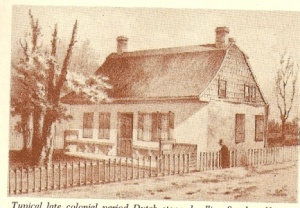
Towards the end of the colonial period, Maspeth had developed considerably. Trade had increased and England was collecting a considerable amount of taxes on the success of Maspeth. Because of its convenient location, Maspeth became an important waterway village. Vessels loaded with produce sailed along Newtown and Maspeth Creeks on their way to markets in Brooklyn and beyond.
By the mid 1700s, the population of Maspeth was still relatively low due to the blossoming of Newtown Village, with most of the settlers living clustered around Newtown Creek. At this time, the population of the entire area did not exceed 1,000 (men, women and children), but the town was full of craftsmen. As early as 1662, there were already two tailors, a cooper, a mason, and a blacksmith. 1711 saw an influx of new settlers, and by 1720, there were wheelwrights, wool combers, butchers, saddlers, and weavers. The town was bustling with activity.
The farms in the area were extremely successful, bringing in rich bountiful harvests: so much so in fact that prices were driven down considerably low. In 1730, wheat was sold for three shillings a bushel. One of the most notable agricultural happenings in the Maspeth-Newtown region is the Newtown Pippin apple, which was first grown in the region in 1730. It immediately became a large success, fetching $20 a barrel in Europe, bringing renown to the region, and recognition from both Benjamin Franklin and Thomas Jefferson.
At the close of the colonial period, Maspeth residents achieved comfort in their homes. Homes were larger and sturdier than the earlier thatched cottages of the 1600s.
In 1760, the Quakers built their first formal Meeting House and cemetery in Maspeth where St. Stanislaus Church now stands. At this time, public education became an issue of great importance, and 1734 saw the construction of the first schoolhouse near modern-day Mt. Zion Cemetery.
During the French and Indian War, companies of soldiers left from New York City to fight for the English, including amongst them, members of the Maspeth-Newtown community. In the winter of 1756, a company of English soldiers was quartered in the area, and in 1757, captured French officers were held in Maspeth as prisoners of war.
Maspeth before the Revolution was on the brink of great change and development.
The Revolution
Maspeth became an important British hold during the Revolution. Maspeth residents were divided over whether they should support the fight for independence to side with the English. Maspeth was closely connected to England, and did not want to separate, however, many villagers joined the continental army. Much opposition to the English developed after the British occupation of New York[9]
Upon hearing of the approach of the British, the militia drove out the cattle of the Maspeth area into Hempstead Plains where they would remain hidden from British soldiers. The Newtown Militia joined forces with a Brooklyn militia and entered the command of General Greene. The Maspeth-Newtown militia was under the control of local Colonel Jeromus Remsen. They lost after a rough struggle in the Battle of Long Island, and the British took control of the area for seven years, aided by local Tories.
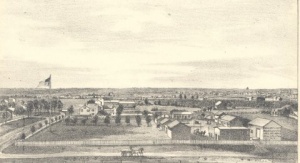
Maspeth escaped the battlefield, but under the Quartering Act, villagers were made to house and feed British soldiers for the duration of the Revolution. During the seven years of occupation, Maspeth Newtown residents were forced to house the soldiers through the harsh winters. Each year it became more and more difficult for the households to survive the winter. Firewood was scarce, as were food and supplies.The town suffered greatly during the period due to the over taxation of the supplies. Many villagers grew angry.
The house of Judge Joseph Sackett, built around 1710, was used as a local headquarters for the British army in the Revolution. The invasion and British occupation of New York was planned there[11]. Dewitt Clinton took residence there in the early 1800s [12].
After the revolution, anti-Tory sentiment was widespread in Maspeth, and many Loyalists were forced to flee to Canada for their lives. Directly after the revolution, Maspeth experiences a period of growth. Transportation was re-vamped through the construction and improvement of roads and bridges, bringing an increase in trade and commerce to Maspeth.
Post Revolution Growth
After the revolution, Maspeth experiences a period of growth. Transportation was re-vamped and expanded through the construction and improvement of roads and bridges, bringing an increase in trade and commerce to Maspeth. Roads were resurfaced with crushed oyster shells and wooden planks.[13]
Maspeth was changed forever just before the Civil War when industry first came to appeared there. The earliest factories to come to the Maspeth area were drawn to the convenience of Newtown Creek and the tributaries throughout western Maspeth[14] The jobs available in the new factories drew early Irish and German immigrants to Maspeth. From this time onward, Maspeth would be home to immigrants. One of the earliest factories in the Maspeth area was the famous glue factory of Peter Cooper, who eventually founded the Cooper Union. His factory, which opened on the Williamsburg bank of Newtown Creek, provided occupations for many Maspeth residents[15]
Another great change that forever shaped and altered the nature of Maspeth was the establishment of Calvary Cemetery. Due to the ever increasing real-estate costs, growing city, and high death rates caused by the cholera epidemics, New York City legislatures passed a law in 1852 that decreed that no more land would be used for cemeteries in Manhattan and that new burials would have to take place elsewhere. Religious institutions began looking out to what would soon become the “boroughs” of New York City[16]. Due to its convenient location, Maspeth was chosen as an ideal site for cemeteries, and the Catholic Church opened Calvary Cemetery and began a ferryboat line to bring visitors to and from the cemetery. Stagecoach lines were also opened to allow people to visit from other areas. Other cemeteries soon followed, such as Mt. Olivet, which originally opened locally in 1951 as part of the Episcopal Church of Maspeth and then opened itself to all faiths a few years later, and Mt. Zion, which was established in 1893. Today, a large portion of Maspeth’s “best land” is used by cemeteries: Mt. Zion and Mt. Olivet are both located on rising ground offering beautiful views of the Manhattan Skyline[17].
In around 1852, Maspeth began to look more like how it does today after two surveyors, Henry Miller and John Smith, re-set the boundaries of the village and laid out a grid pattern known as a village plat. The town stretched to fill the plat. Mt. Olivet cemetery opened in around 1851, causing more travel and traffic in the village as people came to visit the cemetery. At the same time, industry experienced its first “boom” in Maspeth. An "animal carbon plant" opened between Metropolitan and Grand Avenue, which produced carbon for the refining of sugar and dense black paint, and an oil cloth factory opened in 1862. Other large manufacturing companies opened around the same time. The second half of the 19th century also marked the beginning of the mass influx of immigrants into the Maspeth area, as was the case in the rest of New York City. Many of the opening Maspeth factories hired early Irish and German immigrants. The factory workers continued to purchase the cheaper land available in the newly planned plat, filling it to roughly today’s proportions. The increase in travel, both of the visitors to the cemeteries, and of the famers on the way to the Wallabout Market in Brooklyn, led to the opening of various stores, shops, taverns and hotels along Grand Avenue[18].
Civil War and Industrial Changes
Many Maspeth resident fought for the Union side during the Civil War. The Civil War brought about a mushrooming of industry and new discoveries in technology. By the end of the Civil War, steam-powered machinery became more prominent in industry.
Industry in Maspeth grew at a rapid pace, with businesses seeming to sprout overnight. The expanding industrial section of Maspeth provided occupation for returning war veterans and for incoming German and Irish immigrants. Newtown Creek was an ideal location for industry because of the easy transportation of finished products provided by the waterways. Some factories that appeared include Cord Meyer's carbon factory, a factory manufacturing fifes and penny-whistles for the US Army. Gustavus Haflinger's rope walk and hat cording factory opened around the same time. The Maspeth Bell Foundry was another industrious business that was found in Maspeth.
Industry caused a great increase of population in Maspeth. In 1875, the population of Maspeth (listed for the first time separately from Newtown) was recorded at 1,449. By 1898, the population increased to 4,300.
"Gaslight Era": Turn of the Century
Just before the turn of the century, the post-Civil War industry continued to expand and develop. This period of Maspeth's history is largely marked by the large influx of immigrants from Europe, as was much of New York City. By this time, large factories had developed along Newtown Creek, and they absorbed amongst their workers, large numbers of the newly arrived immigrants. Nichol's Copper Works, for example, employed several hundred immigrants. Another large industry that provided occupation for many Maspeth workers was the National Enameling and Stamping Company.
The average workday for a Maspeth factory workers was from 6 A.M. to 6 P.M. It was necessary for the workers to find housing near their workplace, so many of the immigrants settled in Maspeth. They took up housing in the oldest section of Maspeth, where many of the houses date back to the early 1850s, near Maspeth Avenue.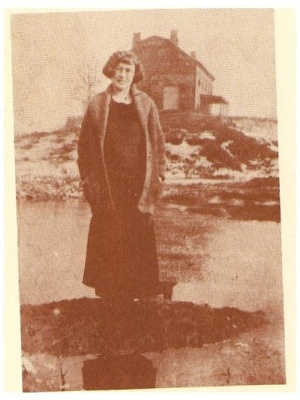
These houses were converted to three or four family homes or boarding houses to try to house the vast numbers of immigrant laborers.
At the turn of the century, most newly arriving immigrants were from Southern and Eastern Europe. Those who came to Maspeth looking for work in the factories settled in ethnic enclaves within the Maspeth community, where they created ethnic shops and cultural institutions. Polish immigrants, for example, were settled in an area near what is now 65th Road [20]
While industry took over most of western Maspeth, parts of Maspeth that were still "countryside" became an attraction to weary city workers seeking a Sunday in the Maspeth parks and cemeteries, further increasing traffic and commerce within Maspeth[21]. Other non-industrial businesses remained in the residential part of Maspeth. While there were no longer any large farms in Maspeth by 1890, some small farms of 10-15 acres, such as dairies and market gardens, were still successful in the village, selling their produce locally. Another strikingly successful occupation that was particular to Maspeth was the florist and “cemetery industry”. The florists’ success was due largely to the “cemetery industry,” which brought much revenue to the region. Transportation continued to improve as a result of the “cemetery industry”[22].More ferry services were started in order to accommodate the large crowds visiting Maspeth’s cemeteries and the parks. By 1893, most of the horse-drawn streetcars were changed to electric cars.
Maspeth's Fire Department was initiated in 1852.
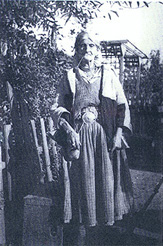
20th Century
20th century Maspeth was a small town within a big city. Small-town values and patriotism rallied Maspeth residents to register for the army at the advent of World War I. Large celebrations were held in honor of the departing enlistees.
Returning troops were also greeted with much fanfare. Returning soldiers after the war came back changed. They small-town feel of Maspeth no longer felt normal to the soldiers who had experienced war. They were thus inspired to become involved in their town, bringing about change in Maspeth. The returning soldiers started businesses, and as a result, even more industry opened in the Maspeth area. Newtown Creek was dredged to a depth of 20 feet from the original 12. In 1908, it had been crossed by 30 thousand vessels; in 1923, it was said to have carried more shipping than the Mississippi River [25]
By 1920, the newly cobble-stoned streets of Maspeth were laid with trolley tracks, increasing traffic and commerce through the town. Many industries expanded including Hardenburgh Uniform Factory, which made naval uniforms, Brunswick Bolke, which produced airplane propellers, Richy, Brown and Donald, which made ornamental ironwork, including the steel windows for the Empire State Building. Gleason-Thibout, another local company, built the electric globes for the Empire State Building. Railings for the bridges of NYC were constructed by local industry in Maspeth, as well as Merrill Bros. Company which made anchors for US Navy ships. Women and child laborers worked in local clay pipe factories, producing pipes and sewer pipes.
Maspeth became a popular residence for immigrants leaving over-crowded Manhattan and Brooklyn. They found jobs in the local industrial section, and lived in the village, which was still relatively "sub-urban". Even in the 20th century, when industry was overwhelming western Maspeth, eastern Maspeth retained the "small town" feel, which is still a trait of the neighborhood today. Small businesses were an integral part of the "village" of Maspeth, and today, Maspeth still remains a “small town within a big city”. Like WWI, World War II saw yet another increase in industry. From WWII until the recession of the 70s, industry in Maspeth grew at an almost alarming rate[26].
In 1954, yet another transportation change occurred that forever changed Maspeth and changed it into the neighborhood that it is today. Under Robert Moses, an expressway was constructed that cut through the very heart of Maspeth: the Long Island Expressway. A great swath was cut through the town, taking with it many of Maspeth's historic buildings and oldest local businesses. Although the expressway allowed Maspeth industries to transport their products more rapidly and cost-efficiently, the expressway took away some of Maspeth’s character and essence. It marked the triumph of industry over people, forever binding it by its asphalt trenches. Like the LIE, industry has also had major drawbacks in Maspeth. Although industry provided the livelihood to thousands of Maspeth residents and brought the town wealth, it has poisoned and polluted Maspeth’s waterways and air. Newtown Creek has become so polluted that it can no longer support aquatic life. It fails to meet even the most basic standards of the 1972 Clean Water Act[27]. Decades of industrial growth without environmental sanctions or standards placed on the factories and companies have resulted in horrible levels of pollution in the neighborhood[28]. This has had negative affects on the health of the residents as well as the neighborhood. The closer one gets to Industrial Maspeth, the lower the price of real estate becomes[29].
Recent Years
Today Maspeth remains a small town within the big city. Maspeth residents are proud of their history, and show their community pride through banners, painted garbage cans and fire hydrants, and active participation in the community[30]. Many of the shops on Grand Avenue are buildings altered from the late 1800s[31]. Maspeth has a small-town feel of one and two-story storefronts lining the major streets and row houses of one and two family on all the other side streets.
In a manner that is relatively unique to Maspeth and perhaps other small towns, real estate sales and the transfer of property usually occurs within the same family, parents to children, nephews, brothers and sisters, or to other members of the Maspeth community[32]. Most houses are not sold on the market. This is considered a form of housing discrimination, but most residents argue against it. Residents believe that hardworking homeowners who purchased their land and built their homes with money they earned working long hours in the factories are unlikely to sell to "just anyone."
Housing in Maspeth consists mostly of one- and two-family houses. Maspeth residents have an appreciation for the smaller older houses that comprise most of the neighborhood’s housing stock. Residents are unhappy with the newer multi-family dwellings that sprout up occasionally. They feel that the newer houses take away from the charm of the neighborhood. While this does happen in Maspeth, especially in the past five years, it is by no means the norm. In comparison to neighboring areas, the construction of multi-family housing units is drastically less, owing in part to the lack of direct public transportation to Manhattan and to the tendency of Maspeth residents to “shut out” outsiders. Part of this isolationist “small town” mentality of Maspeth residents is their fear that Maspeth will “fall” like other New York neighborhoods[33].
According to the 2000 census, Maspeth was home to 37,000 people, amongst them, large numbers of immigrant families. Most immigrant families are from Poland and Ireland, both groups have been a staple in Maspeth for a large portion of its history. New Polish immigrants are drawn to Maspeth and its neighboring Ridgewood and Middle Village due to the gentrification of Greenpoint and Williamsburg[34]. Maspeth also has significant numbers of German and Italian immigrants and the largest population of Lithuanians outside of the Chicago area. In recent years, Maspeth has seen Chinese and Korean immigrants and an increase in minorities, also believed to be leaving Greenpoint/Williamsburg. The overall affordability of housing in Maspeth continues to draw immigrants, as it has done in the past, although today, not many jobs can be found in industrial Maspeth.
Homes in Maspeth are generally less expensive that surrounding areas. Detached one-family homes and attached town houses are priced at around $ 500,000; 2-family homes are under $600,000. Newly constructed 3-family homes are over $800,000. Rent in 2-family homes is placed around $1,000. In the last year, prices of homes in Maspeth have dropped from 8% to 10%. Some homeowners enter the market with high asking prices, and the properties remain unsold “like lead balloons”, says local real estate agent Mr. Pastorini[35]. As a result of the overall change of the US economy from an industrial to a service sector economy, and the recent economic downturn, Maspeth’s industry has slowed down greatly in recent years. Maspeth remains a relatively safe neighborhood, though the deserted industrial areas are best avoided at night.
The continued industrialization of Maspeth for over 100 years has had both negative and positive effects on the community. The wealth and occupation for the residents was very good for the development and essence of the community and the identity of its residents as hard working blue-collar people, but the environmental impact of the unchecked industrialism is immeasurably horrible. Another negative impact of the continued industrialization and the installation of the LIE and BQE expressways was the loss of some of Maspeth’s colonial landmarks. Apply named Rust Street, which is now an industrial wasteland, was once home to many of the earliest colonial houses. In fact, the settlement near Mt. Zion is now home to thousands of factories. The few homes that are still standing in that area are greatly run down, but are real treasures looking back into the history of Maspeth. The need to preserve these historic buildings was presented in the fight between Maspeth residents and developers over St. Saviour’s church, which stood on the corner of Rust Street and 57th Drive. It was built in 1847 and was designed by the famous architect Richard Upjohn, who also designed Trinity Church[36]. This contrast between industry and residential Maspeth is just one of the many qualities that makes Maspeth a truly unique neighborhood.
References
- ↑ http://www.queensnewyork.com/maspeth/chamberof/history.html
- ↑ Stankowski, Barbara. Maspeth...our town.
- ↑ http://www.queensnewyork.com/maspeth/history.html
- ↑ http://www.queensnewyork.com/maspeth/history.html
- ↑ http://www.queenslibrary.org/index.aspx?page_nm=CL-Communityinfo&branch_id=MA&#clhistory
- ↑ http://www.queensnewyork.com/maspeth/chamberof/history.html
- ↑ Stankowski, Barbara W. Maspeth...our town. 1977
- ↑ Stankowski, Barbara W. Maspeth...our town. 1977
- ↑ Stankowski, Barbara W. Maspeth...our town. 1977. Print.
- ↑ http://www.bklyn-genealogy-info.com/Queens/history/light.jpg
- ↑ http://www.queensnewyork.com/maspeth/history.html
- ↑ http://www.forgotten-ny.com/STREET%20SCENES/blissville/blissville.html
- ↑ Stankowski, Barbara W. Maspeth...our town. 1977. Print.
- ↑ Stankowski, Barbara W. Maspeth...our town. 1977. Print.
- ↑ http://www.forgotten-ny.com/STREET%20SCENES/maspeth/maspeth.html
- ↑ Stankowski, Barbara W. Maspeth...our town. 1977. Print.
- ↑ http://queens.about.com/od/neighborhoods/p/maspeth.htm
- ↑ http://www.queensnewyork.com/maspeth/history.html
- ↑ Stankowski, Barbara W. Maspeth...our town. 1977
- ↑ Stankowski, Barbara W. Maspeth...our town.1977
- ↑ http://queens.about.com/od/neighborhoods/p/maspeth.htm
- ↑ Stankowski, Barbara W. Maspeth...our town. 1977.
- ↑ Stankowski, Barbara W. Maspeth...our town. 1977
- ↑ http://www.smithsonianeducation.org/migrations/gyp/lud.html
- ↑ Stankowski, Barbara W. Maspeth...our town. 1977
- ↑ Stankowski, Barbara W. Maspeth...our town. 1977
- ↑ http://www.pbs.org/pov/borders/2004/water/water_creek.html
- ↑ Stankowski, Barbara W. Maspeth...our town. 1977. Print.
- ↑ http://queens.about.com/od/neighborhoods/p/maspeth.htm
- ↑ http://www.nytimes.com/2008/05/04/realestate/04livi.html?_r=1
- ↑ Stankowski, Barbara W. Maspeth...our town. 1977. Print.
- ↑ http://www.nytimes.com/2008/05/04/realestate/04livi.html?_r=1
- ↑ http://www.nytimes.com/2008/05/04/realestate/04livi.html?_r=1
- ↑ http://www.nytimes.com/2008/05/04/realestate/04livi.html?_r=1
- ↑ http://www.nytimes.com/2008/05/04/realestate/04livi.html?_r=1
- ↑ http://www.forgotten-ny.com/stsaviors.html
